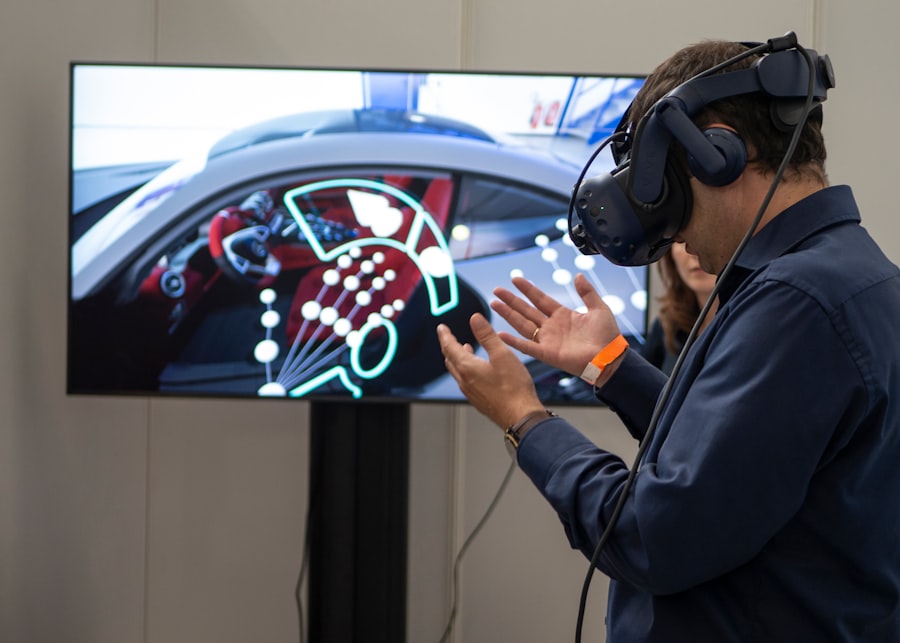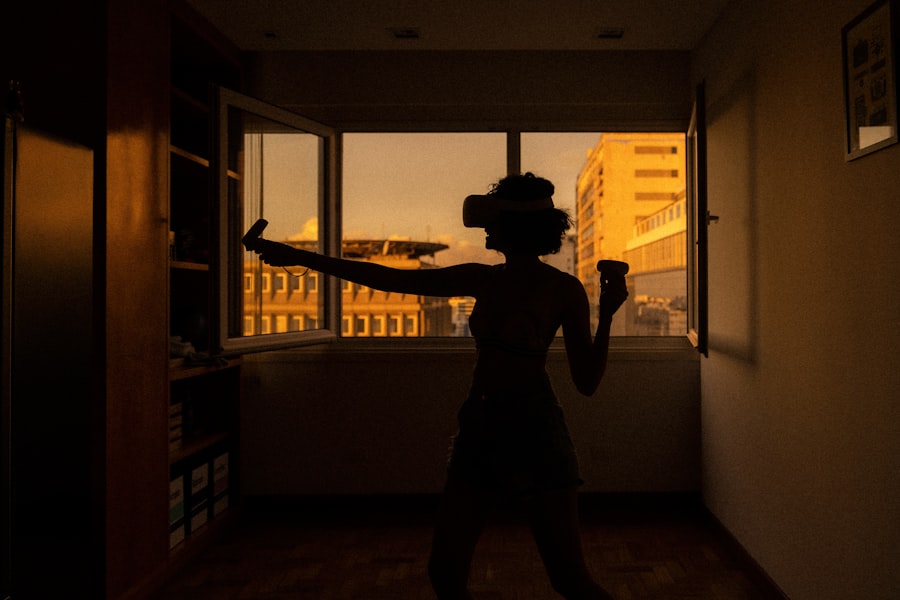Download links
Description
The concept of virtual reality (VR) has evolved significantly since its inception, transitioning from a niche technological curiosity to a mainstream phenomenon that permeates various aspects of daily life. The roots of VR can be traced back to the 1960s with the creation of the Sensorama, a multi-sensory machine designed to immerse users in a simulated environment. However, it wasn’t until the 1990s that VR began to capture the public’s imagination, largely due to the advent of more sophisticated technologies and the introduction of devices like the Virtuality Group’s arcade machines.
These early experiences, while rudimentary by today’s standards, laid the groundwork for the immersive experiences we see today. Fast forward to the 21st century, and VR has undergone a remarkable transformation, driven by advancements in computing power, graphics rendering, and motion tracking technologies. The launch of consumer-grade headsets such as the Oculus Rift in 2016 marked a pivotal moment in the industry, making VR accessible to a broader audience.
This democratization of technology has spurred innovation across various sectors, including education, healthcare, and entertainment. As VR continues to gain traction, it is reshaping how we interact with digital content and each other, creating new opportunities for engagement and exploration in a virtual realm that feels increasingly real.
Key Takeaways
- Virtual reality has seen a significant rise in popularity, offering users an immersive digital experience.
- Navigating virtual environments allows users to explore and interact with digital landscapes in new and exciting ways.
- Virtual communities have a profound impact on building connections and fostering relationships in the digital world.
- The virtual economy is expanding, with digital marketplaces and transactions becoming increasingly prevalent.
- Virtual entertainment, including gaming and digital media, continues to evolve and shape the digital world.
Navigating the Virtual Landscape: Exploring Virtual Environments
The virtual landscape is a vast and diverse terrain that encompasses a multitude of environments, each designed to provide unique experiences. From expansive open worlds in video games to meticulously crafted simulations for training purposes, these virtual environments are engineered to engage users on multiple sensory levels. One notable example is “Second Life,” a pioneering virtual world launched in 2003 that allows users to create avatars and interact with others in a user-generated environment.
This platform has become a social experiment in digital identity and community building, showcasing how virtual spaces can foster connections among individuals from different backgrounds. In addition to social platforms, VR has found applications in professional training and education. For instance, medical schools are increasingly utilizing VR simulations to train students in surgical procedures without the risks associated with real-life operations.
Programs like Osso VR provide an immersive training experience that allows aspiring surgeons to practice techniques in a controlled environment. Similarly, architectural firms use VR to create walkthroughs of buildings before they are constructed, enabling clients to visualize spaces and make informed decisions. These examples illustrate how navigating virtual environments can enhance learning and professional development by providing experiential opportunities that traditional methods cannot replicate.
The Impact of Virtual Communities: Building Connections in the Digital World

Virtual communities have emerged as powerful social constructs that transcend geographical boundaries, allowing individuals to connect based on shared interests rather than physical proximity. Online platforms such as Reddit, Discord, and various gaming communities have become hubs for discussion, collaboration, and support. These digital spaces foster a sense of belonging among users who may feel isolated in their offline lives.
For instance, gamers often form tight-knit communities around specific titles or genres, sharing strategies, experiences, and even personal stories that deepen their connections. Moreover, virtual communities have played a crucial role in activism and social movements. The Arab Spring is a prime example of how social media and online platforms facilitated organization and mobilization among activists.
In this context, virtual spaces became vital for sharing information and rallying support for causes that might have been suppressed in traditional media outlets. The ability to connect with like-minded individuals across the globe has empowered marginalized voices and created networks of solidarity that challenge societal norms and injustices.
Virtual Economy: Exploring Digital Marketplaces and Transactions
| Metrics | Data |
|---|---|
| Number of digital marketplaces | 50 |
| Annual transaction volume | 2.5 trillion |
| Percentage of global retail sales | 20% |
| Number of virtual goods sold annually | 1.8 billion |
The rise of virtual reality has given birth to an entirely new economy characterized by digital marketplaces and transactions that operate within these immersive environments.
Platforms like Decentraland and The Sandbox allow users to buy, sell, and trade virtual land using cryptocurrencies, creating a new frontier for investment and entrepreneurship.
Additionally, the concept of non-fungible tokens (NFTs) has revolutionized how digital art and collectibles are bought and sold. Artists can tokenize their work on blockchain platforms like OpenSea or Rarible, granting them ownership rights while providing buyers with verifiable authenticity.
This shift has not only opened new revenue streams for creators but has also sparked debates about copyright, ownership, and the value of digital art in an increasingly digitized world. As these virtual economies continue to evolve, they challenge our understanding of commerce and ownership in ways that were previously unimaginable.
Virtual Entertainment: The Evolution of Gaming and Digital Media
The entertainment industry has been profoundly impacted by the rise of virtual reality, particularly within gaming and digital media. The immersive nature of VR allows players to step into their favorite games like never before, creating experiences that are both engaging and interactive. Titles such as “Beat Saber” and “Half-Life: Alyx” have set new standards for gameplay by leveraging VR’s capabilities to create dynamic environments where players can physically interact with their surroundings.
This evolution has not only transformed gameplay mechanics but has also redefined storytelling within games, allowing for more nuanced narratives that respond to player choices. Beyond gaming, VR is making significant strides in the realm of digital media consumption. Platforms like Oculus TV and Bigscreen enable users to watch movies or attend live events in virtual theaters with friends or strangers from around the world.
This shift towards shared experiences in virtual spaces reflects a growing desire for social interaction even when physically apart. As technology continues to advance, we can expect further innovations that blur the lines between gaming, film, and interactive storytelling, creating rich narratives that captivate audiences in unprecedented ways.
The Future of the Digital World: Exploring the Potential of Virtual Reality

Looking ahead, the potential of virtual reality is vast and largely untapped. As technology continues to advance at an exponential rate, we can anticipate more sophisticated hardware and software solutions that will enhance user experiences across various domains. One area ripe for exploration is the integration of artificial intelligence (AI) within VR environments.
AI could enable more responsive and adaptive virtual worlds where non-player characters (NPCs) exhibit lifelike behaviors or where environments dynamically change based on user interactions. Moreover, as 5G technology becomes more widespread, it will facilitate seamless connectivity for VR applications, reducing latency and enhancing real-time interactions within virtual spaces. This advancement could lead to more immersive multiplayer experiences where users can collaborate or compete without the hindrance of lag or disconnection issues.
Additionally, as concerns about mental health and well-being grow in our increasingly digital society, VR could offer therapeutic applications for anxiety or phobias through controlled exposure therapy in safe environments. In conclusion, the future of virtual reality holds immense promise as it continues to evolve and integrate into our daily lives. From enhancing education and training to revolutionizing entertainment and social interactions, VR is poised to redefine our relationship with technology and each other in profound ways.
As we navigate this digital frontier, it is essential to consider both the opportunities and challenges that come with such transformative advancements.
If you are interested in exploring virtual worlds and immersive experiences, you may also enjoy reading about the most-rated apps on Taya365. These apps offer a variety of virtual experiences and entertainment options that can enhance your virtual life. Check out the article here to discover new ways to engage with virtual reality and digital environments.
FAQs
What is virtual life?
Virtual life refers to the experience of living and interacting in a digital or virtual environment, often through the use of technology such as virtual reality, augmented reality, or online platforms.
What are some examples of virtual life?
Examples of virtual life include virtual reality games and simulations, social media platforms, online communities, and virtual worlds such as Second Life and The Sims.
How does virtual life differ from real life?
Virtual life differs from real life in that it takes place in a digital or simulated environment, and the interactions and experiences are mediated by technology. While virtual life can offer a sense of escapism and creativity, it may not always accurately reflect the complexities and nuances of real life.
What are the benefits of virtual life?
Some potential benefits of virtual life include opportunities for creativity and self-expression, the ability to connect with others from around the world, and the potential for immersive and engaging experiences.
What are the potential drawbacks of virtual life?
Drawbacks of virtual life may include issues related to privacy and security, the potential for addiction or over-reliance on technology, and the risk of disconnecting from real-life relationships and experiences.
How is virtual life impacting society?
Virtual life is impacting society in various ways, including influencing how people socialize, work, and entertain themselves. It has also raised questions about the boundaries between the digital and physical worlds, and the implications for mental health and well-being.





